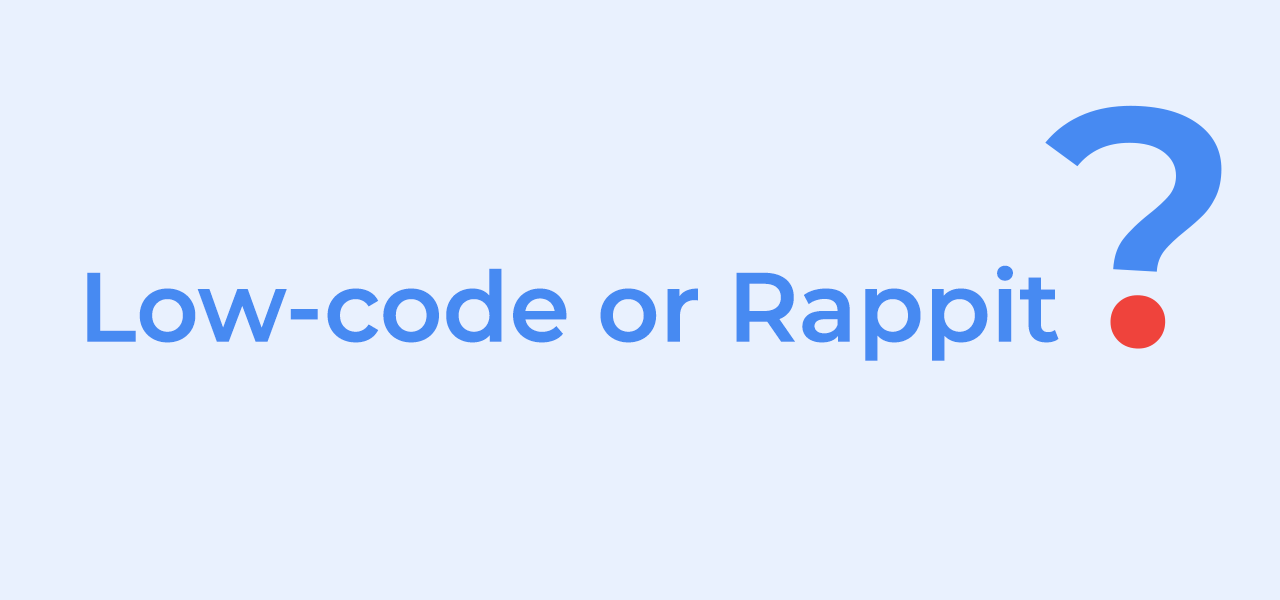What is the difference between low-code platforms and Rappit Developer? Top 6 questions answered.
Are you considering partnering with a low-code platform like Mendix or OutSystems? Do you question whether it’s the right path for you? Are you wondering what alternatives there are to low-code platforms?
To create high-quality enterprise applications in a smaller amount of time you need the right tools. Low-code platforms can be the right choice for you. They give your team the opportunity to build apps fast even with limited programming skills. But when you need to develop complex customized apps, most low-code platforms actually slow you down. So how do you choose a platform that saves you time and lives up to your expectations?
With more than four decades of experience in developing enterprise applications, we’re well aware of the limitations associated with low-code platforms. Like so many we faced challenges when customizing generated code. We struggled with the high rising cost per end user. And we wrestled with vendor lock-in.
In this blog, we’re going to compare low-code platforms with our high-productivity tool Rappit Developer. This will help you understand what platform is the best fit for your company.
How do development speed and productivity differ between low-code platforms and Rappit Developer?
The main task of both platforms is to increase developer productivity. It’s done by enabling the development of software applications with minimal hand-coding through a visual, intuitive interface.
Low-code platforms like Mendix or OutSystems allow you to build applications quickly. The building blocks offered fit well for creating straightforward enterprise applications. However, delays can occur when creating non-straightforward features. Low-code platforms are rigid when code needs customization due to restrictions. In such cases, developers have to create workarounds that consume a significant amount of time.
A high-productivity tool like Rappit Developer offers the same speed in building straightforward applications as a low-code platform. However, it generates high-quality code and empowers developers to easily customize it outside the tool. This combination significantly accelerates the development of complex applications compared to low-code platforms.
The difference between Rappit Developer and low-code platforms in terms of development speed and productivity depends on the type of applications you want to build. Low-code platforms allow you to quickly create straightforward business applications.
However, if you want to build complex business features, it’s better to choose Rappit Developer. Rappit Developer generates high-quality code that is easily customizable, which is much faster than in low-code platforms. These platforms not only create inferior code, resulting in slow performance under demanding conditions, but they also make it difficult for developers to modify code due to various restrictions.
What types of applications can be built with low-code platforms and Rappit Developer?
Low-code platforms are appropriate for building applications with minimal customization complexity and when the application only needs the functionality directly supported out-of-box. They excel in automating repetitive tasks, workflows, enterprise processes, and document management.
Rappit Developer enables the development of straightforward enterprise applications. Yet, it excels in creating customized, scalable, and robust cloud-native applications on serverless and managed cloud technologies. These capabilities cater to complex logic and functionality requirements.
What applications are built with low-code platforms and Rappit Developer?
Applications built with Low-code platforms are
- Forms
- Surveys
- Data collection apps
- Approvals
- Notifications
- Internal tools
- Departmental apps
- Dashboards.
Applications built with Rappit Developer are.
- Replacements for Advanced Lotus Notes applications
- Replacements for Oracle Form applications
- Highly scalable Cloud-native applications
- HR systems
- CRM
- Incident Management applications
- Quality Management applications
- Financial applications
- Transportation Management applications
- Project Management applications
- Smaller enterprise applications that require complex customizations
How intuitive is the user interface and development environment of low-code platforms and Rappit Developer?
Low-code platforms are highly intuitive. Developers can utilize visual elements, pre-built components, and declarative programming techniques to construct applications. The platforms feature drag-and-drop interfaces, pre-built templates, reusable components, and automated code generation.
Rappit Developer is highly intuitive, offering visual tools and instant prototyping that enable business domain experts to get a clear picture and visualize the app’s appearance up front. Developers maintain full flexibility to make adjustments according to their requirements. Moreover, as an “opinionated system,” Rappit Developer leverages established best practices in building enterprise apps, automatically generating pages, layouts, and code.
What are the challenges involved in migrating out of a platform?
Most companies are concerned about over-dependence on one platform. They want the ability to move out of a platform. There are various reasons driving this choice. These include outdated vendor technology, the preference to safeguard customer data in their own secure cloud, and the rising expenses associated with user subscriptions and applications.
While most low-code platforms claim their products don’t have vendor lock-in, this is not true. When users want to migrate out of the platform, they face various restrictions.
Upon canceling the subscription of most Low-code platforms, both the platform itself and the applications built within it will no longer function. While it is possible to obtain the generated code, it requires significant modifications to ensure the code functions correctly when migrating to a new platform. This process can be time-consuming and demands the expertise of developers familiar with both the original and the new platform.
Transferring data from a low-code platform can be another challenge. Data models and database structures might differ, requiring data mapping, transformation, and potential data cleansing or reformatting during the migration process.
High-productivity tool Rappit Developer is based on open standards and popular open-source libraries (Java-based). It provides flexibility and portability, enabling users to migrate their applications to different platforms or environments if desired, without proprietary technologies tying them down or causing significant barriers to transition.
If you need to be able to change to a different platform when needed, Low-code platforms like Mendix and OutSystems are not the best option for you. They make a smooth transition hard. Rappit Developer generates real code (Java) enabling developers to make modifications seamlessly, independent of Rappit Developer.
How do pricing and licensing models work for low-code platforms and Rappit Developer?
Most low-code platforms base their price on the number of end-users, the size and complexity of the application, and the volume of data processed by the applications built on the platform. The more people use your applications, the higher the costs. Rappit Developer bases its price on the number of developers, so the number of end-users is irrelevant.
Remember that code created in low-code platforms does not always perform optimally. It can drastically slow down the processing of large data, resulting in high cloud costs. Rappit Developer generates high-quality code and it’s highly flexible in modifying it, so running into these kinds of issues is unlikely.
So if you need straightforward applications intended for limited usage and won’t be processing large amounts of data, opting for a low-code platform is potentially a good choice. However, if you want to build applications for a medium to large number of users and have the capability of processing substantial amounts of data, Rappit Developer is the better choice for you.
Conclusion
The choice of platform that best suits your company depends on the type of applications built and the target user.
When building straightforward enterprise applications low-code platforms are the right choice. They are well suited for building applications with minimal customization complexity. The development and productivity speed are adequate. And the user interface and development environment are highly intuitive. They excel in creating various applications, including forms, surveys, data collection apps, and approval systems.
However, Low-code platforms come with a set of challenges that need to be considered. These challenges include the complexity (or even impossibility) of migrating to alternative platforms, the limitations on code customization, and the generation of low-quality code. Consequently, the development and productivity speed of complex applications suffers, leading to higher costs. As the company grows, the pricing model based on the number of end users can considerably increase subscription costs.
When building demanding and advanced applications Rappit Developer is the better option. It lets you easily adjust code without restrictions and creates higher-quality code for optimal application performance. Rappit Developer excels in rapidly constructing complex, scalable, and robust cloud-native applications, such as replacements for advanced Lotus Notes applications and Oracle Form applications, as well as HR systems and CRM solutions. Its pricing model is perfect for expanding medium to large companies, as it relies on the number of developers rather than end users.



